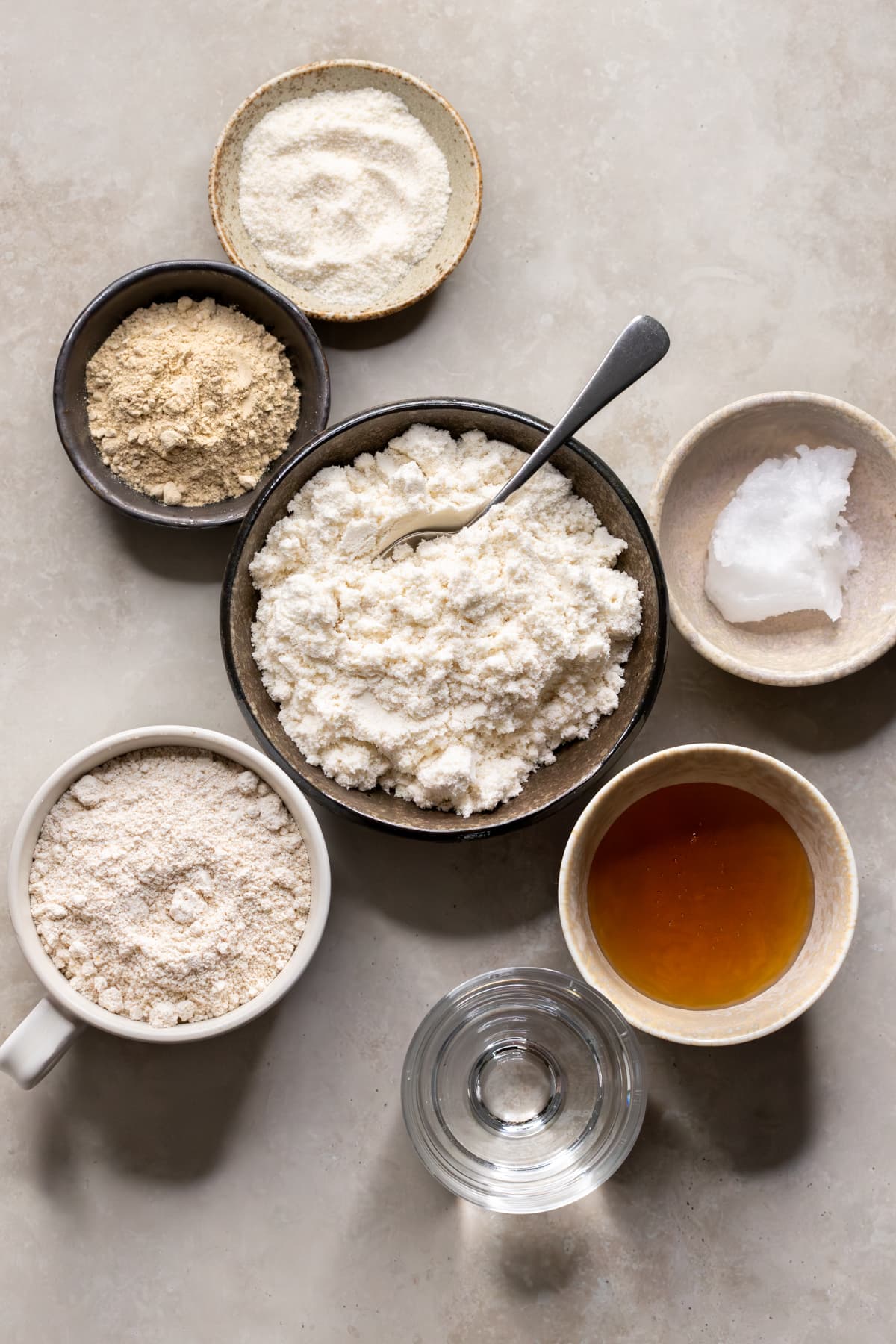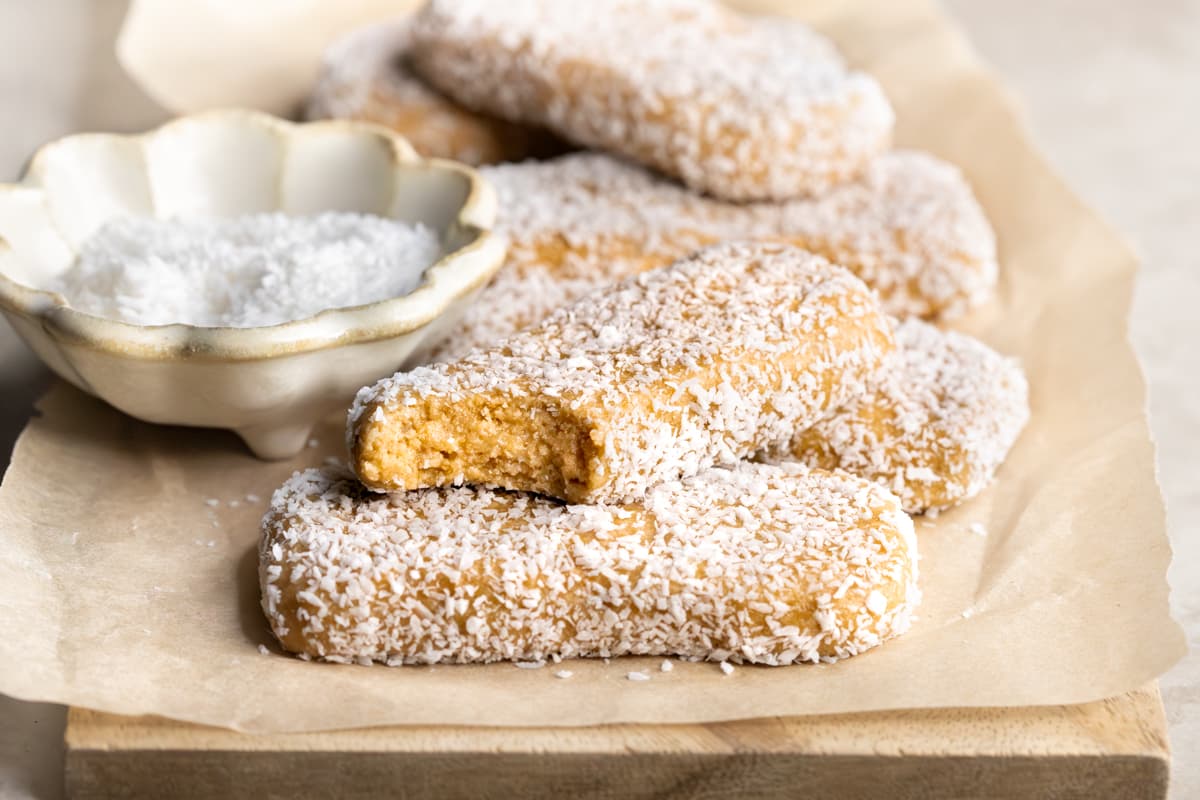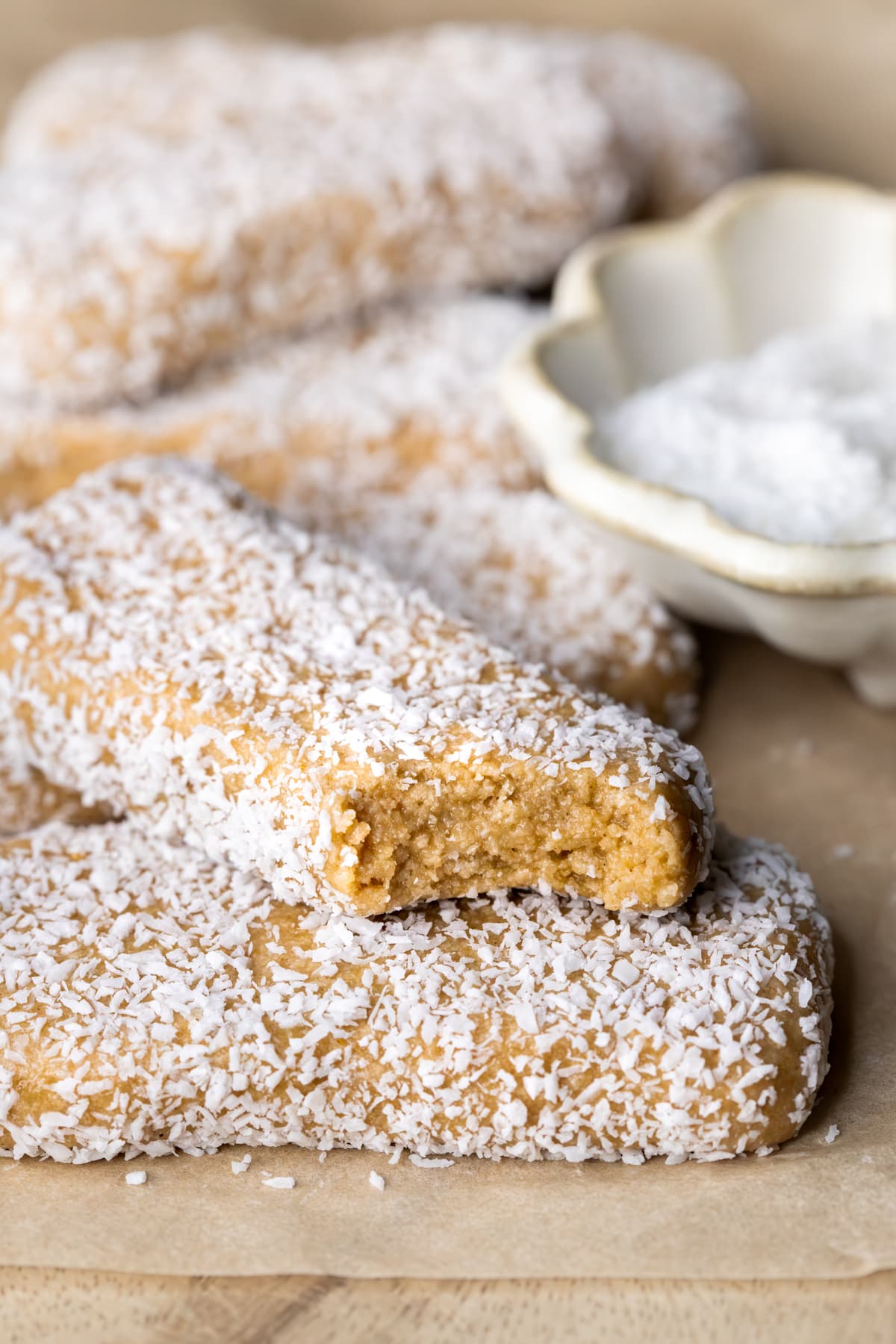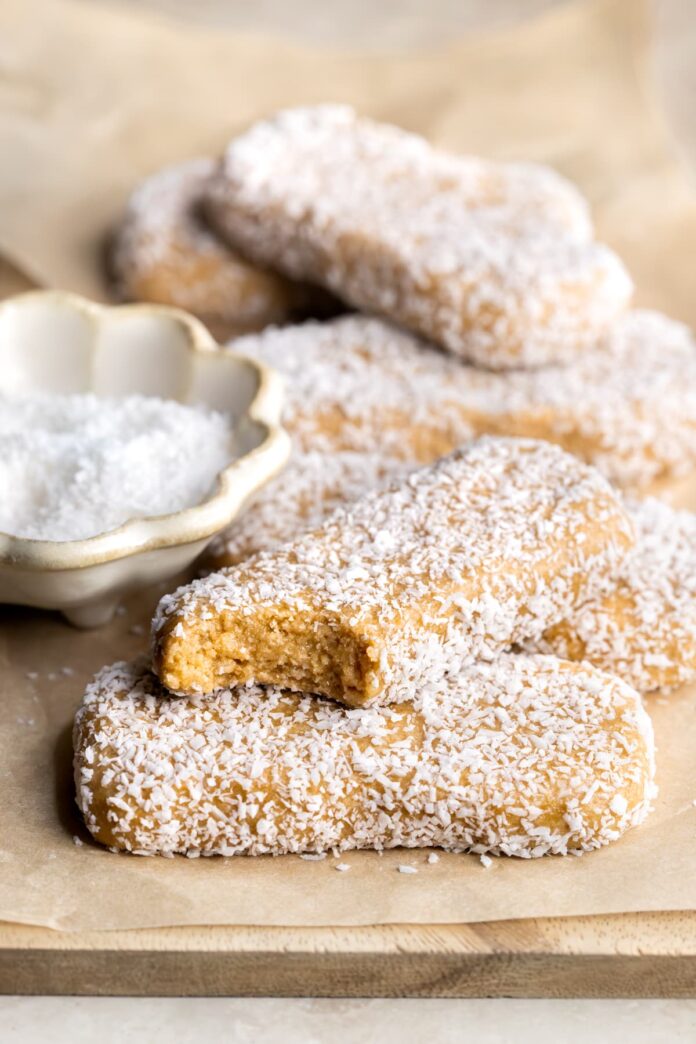These Clean Protein Bars are easy to make with just a bowl and a spoon. They are high protein, gluten free and nut free. Plus, they don’t contain any artificial sweeteners or sugar alcohols.
I divide the recipe into six bars, with each bar containing 180 calories and just over 13 grams of protein. You can check out the full protein bar nutrition facts under the recipe below. If you prefer larger bars with a higher dose of protein, you can simply divide the mixture into four bars, which gives 270 calories with 20 grams of protein.
Are protein bars clean?
Many store bought protein bars advertise themselves as healthy, but if you take a closer look at the ingredient list, they aren’t always ideal. Sometimes they contain a large amount of added sugar. They can also include lower quality ingredients as fillers.
Another issue for some people is the fact that so many protein bars are sweetened with artificial sweeteners or sugar alcohols like erythritol. This keeps calories and sugars to a minimum, but these types of sweeteners can sometimes cause digestive discomfort.
A healthier alternative can be to make your own protein bars at home. That way, you can choose what goes into them. It also allows you to customise the bars to suit your personal taste.

What protein powder works best for protein bars?
When choosing a protein powder for homemade protein bars, it’s best to stick to what the recipe recommends. This is because different protein powders behave differently when mixed with other ingredients. When I develop a protein bar recipe, the other ingredients are carefully chosen to suit the selected protein powder and to ensure that the end result isn’t too dry or too sticky.
In this recipe, whey protein powder is needed because its stickiness when mixed with the water helps to bind the bars together. Whey protein isolate or whey protein concentrate will both work. For plant-based or vegan protein bars, you usually need to add a little extra fat to the recipe to avoid a dry result.
I also often choose unflavored protein powders when making protein bars. This is because adding larger amounts of sweetened and flavored protein powders to a recipe can make the bars taste a bit artificial. However, if you enjoy the taste of your flavored protein powder it may be ok.

Ingredients for clean protein bars
- Whey protein powder: For this recipe, I use unflavored whey protein isolate, then add my own flavors and sweetener. I also use quite a bit of protein powder, compared to some recipes, to give a decent amount of protein per bar.
- Oat flour: Oat flour blends with the whey protein powder to give the bars a firmer texture. You can make your own oat flour by simply blending rolled oats in a food processor or blender until it turns into a flour consistency.
- Maca powder: I love the butterscotch-like taste of maca powder to flavor these protein bars. However, you could substitute cocoa powder, mesquite powder, lucuma powder or even a freeze-dried berry powder if you prefer.
- Coconut flour: A small amount of coconut flour works with the oat flour to give these protein bars structure.
- Coconut oil: I use a little coconut oil to improve the texture of the bars. It sets firm when you chill the bars, which also helps to hold things together.
- Brown rice syrup: Since I use an unflavored protein powder, brown rice syrup sweetens the bars. Maple syrup or honey will also work as substitutes. If you wanted to make sugar-free protein bars, you could use a sugar-free liquid sweetener.
- Water: I add some water to this recipe to help the whey protein powder blend with the other ingredients.
- Desiccated coconut: Since these bars are on the stickier side before they are chilled, I lightly coat them in some unsweetened desiccated coconut. This makes them easier to handle and stops them from sticking to each other.

More protein bar recipes
- No Bake Almond Nougat Protein Bars
- Cookie Dough Protein Bars with Collagen Powder
- Vegan Peanut Butter Oat Protein Bars
- Nut Free Cookie Dough Protein Bars
- Chewy Choc Chip Oat Protein Bars
Check out the Protein Powder Recipes page for more ideas.
Clean Protein Bars Recipe
Serves
6 bars
Prep time
10 mins
Cook time
20 mins chilling
Ingredients
- 3/4 cup / 75 g unflavoured whey protein powder (see Note 1)
- 3/4 cup / 68 g oat flour (see Note 2)
- 8 tsp / 19 g maca powder (see Note 3)
- 4 tsp / 9 g coconut flour
- 4 tsp / 20 ml / 19 g coconut oil, melted
- 8 tsp / 40 ml / 58 g brown rice syrup
- 1/4 cup / 60 ml / 60 g water
- 2 tbsp / 12 g unsweetened desiccated coconut, for coating
Method
- Tip the whey protein powder, oat flour, maca powder and coconut flour into a bowl and mix to combine. Pour in the melted coconut oil, brown rice syrup and about half of the water.
- Using a large and sturdy spoon, start stirring the mixture together, adding the remaining water as needed to get a pliable dough. The dough should be slightly sticky, but if it’s way too sticky to manage, add a little extra coconut flour. If it gets too dry, add a little extra water.
- Tip the desiccated coconut for coating onto a plate. Divide the protein bar mixture into six portions and shape each portion into bars using your hands (see Note 4). Press each side of each bar into the coconut to coat. Chill the bars in the fridge for 20 minutes to firm up.
Notes
- Protein powder – Whey protein powder is needed in this recipe because its stickiness when mixed with the water helps to hold the bars together. Whey protein isolate or whey protein concentrate will work. I also use unflavored powder. However, if you want to use a flavored whey protein, just make sure you enjoy the taste of it because it will be noticeable.
- Oat flour – You can make your own oat flour by blending rolled oats in a blender or food processor.
- Maca powder – I use maca powder to flavor the bars and add a little extra sweetness. Mesquite powder or lucuma powder also work well. You could also use cocoa powder for chocolate bars, but you may want to substitute some of the water for a little extra brown rice syrup to counteract the bitterness of the cocoa powder.
- Shaping the dough – I wear plastic food preparation gloves while shaping the dough into bars and coating them in coconut to avoid sticking, but you can do it with clean, bare hands.
- Storage – Store the bars in an airtight container in the fridge for up to 3 days, or freeze them if you will take longer to eat them. You can eat them straight from the freezer or let them soften slightly at room temperature for a few minutes before eating.
Nutrition Facts
- Serving size: 1 bar
- Energy: 180 Calories / 753 Kilojoules
- Total Fat: 5.4 g
- Saturated Fat: 4.2 g
- Total Carbohydrate: 19.6 g
- Dietary Fiber: 2.5 g
- Sugars: 6.1 g
- Protein: 13.3 g
- Sodium: 22 mg
- Potassium: 82 mg

These are so delicious! After hunting for so long for a whey bar recipe that wasn’t chock full of dried fruit and nuts, this recipe is amazing.
So happy you like it Kelly! 🙂 I was the same, it’s so hard to find protein bars without a heap of dried fruit and nuts!
Can the rice malt syrup be substituted with anything? Is it the sweetener?
Hi Allie, yeah the rice malt syrup is the sweetener – you could use another sweetener if you prefer, like pure maple syrup or honey x
I’d imagine that these protein bars, along with some of your other recipes, could simply be kept frozen and just taken out as needed?
Hi Andrea, yep I often freeze the protein bars and other dessert/treat recipes and just defrost them in the fridge as needed. x
Hi! I live in Sweden and cant get that kind of protein powder, can I use hemp protein instead? I’ve never used protein powder before but now that I can find organic natural ones I can rethink using it. These looks so good, so I think I have to make them!
Hi Julia, the whey protein powder when mixed with water becomes quite sticky, which is what holds the protein bars together. If you wanted to use hemp protein, you’ll need to adjust the recipe because I don’t think it will get sticky like the whey.
You could try replacing the 1/4 cup of water with additional coconut oil instead so that when the oil sets in the fridge, it holds the bars together (it might just be a bit tricky to shape the mixture into bars).
Otherwise you could try my Choc Mint Protein Balls, which should work with the hemp protein! I hope that helps! x
I substituted 40ml of the water with lemon juice to mix up the flavour and it was delicious – worked really well with the coconut.
Great to hear it worked out – lemon with the coconut would be delicious!